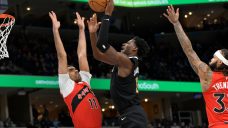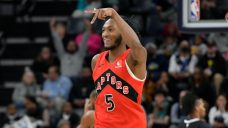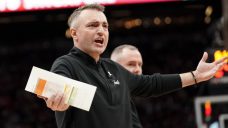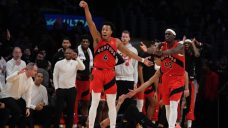The Toronto Raptors look different since the trade. That much we can say with certainty. They’re more fun. More spirited. Built more logically, capably and effectively on offence. It’s been a good start.
How much of this is sustainable, and in which forms, remains a valid question. At the outset of every year, we’re reminded that things start to stabilize around the 20-game mark. It stands to reason that 20 games is a useful sample size following a trade shakeup, too. An exciting 3-3 start is all we have, but we can still examine some of the trends we’re seeing following the paradigm shift.
Here are some early returns to keep an eye on.
Scottie Barnes’ role at both ends
Barnes taking only 10 field-goal attempts Wednesday in a game without Pascal Siakam raised some eyebrows. It was a game, however, in which Barnes saw heavy attention from the Clippers’ stable of quality defensive forwards, and one in which Barnes continued a trend of willingly allowing space for new pieces RJ Barrett and Immanuel Quickley to find their offence. Barnes is a team-first offensive player, someone happy to facilitate for others and use the defensive attention he draws to benefit others.
Still, it’s notable that Barnes’ usage rate has taken a hit since the trade. Over these six games, Barnes ranks fourth on the team in usage rate at 21.3 percent. Prior to the trade, he was second, just narrowly behind Siakam at 24 percent.
Usage rate is a measure of what share of possessions a player finishes offensively while on the court, with either a shot, trip to the free-throw line or turnover. These last five games represent his second-lowest usage five-game stretch of the season, as a scorer.
Barnes has also averaged 5.8 assists during that time and trails only Quickley in assist rate during that time. Usage rate is a helpful indicator, but only of scoring usage; Barnes is still heavily involved in the offence overall. In fact, Barnes leads the team in frontcourt touches per game, and if we blend scoring and passing usage, he trails only Quickley. You can be a very impactful player without a heavy scoring load – there have been seven MVPs in league history with a usage rate below 25 percent, and while the non-Steve Nash examples of that are outdated, one out of every six All-NBA players the last decade have had a sub-25 percent usage rate. (Barnes is at 24.4 for the season now.)
This isn’t to say Barnes shouldn’t be more featured as a scorer. He’s at worst the team’s second-best scoring option, and often their best. What we’re seeing, though, is not a difficulty fitting the new pieces around Barnes. Instead, we’re seeing all the extra attention Barnes has been scoring through this year now being used – with better offensive pieces complementing him – to drive easier offence for the team as a whole. His usage will come back up.
Sub-trend: Barnes is being used all over the place defensively in a post-OG Anunoby world. Based on NBA matchup data I analyzed, the only player in the league guarding across five positions with more versatility right now is Jarred Vanderbilt. Last year, Barnes and Anunoby ranked first and second in my crude metric for positional versatility on defence, and Barnes is once again near the top. That’s immensely valuable, especially since he’s been so effective in the lower part of the floor when needed in more of a free safety big role.
Quickley stole Barrett’s favorite player
One thing I’ve always really appreciated about Barrett is that he’s a legitimate Raptors fan. So much so that he always makes sure to mention Jose Calderon as one of the players he grew up watching. Calderon is king around these parts.
It’s Quickley, though, who is doing a Caleron impression since arriving.
Quickley has dished 37 assists to just six turnovers, a remarkable 6.2:1 ratio. Calderon holds the franchise record for assist-to-turnover ratio in a season at 5.4:1. Calderon obviously did it over a much larger sample than 187 minutes, but you have to respect Quickley’s accidental nod to the history of good Raptors point guard play.
More to the point, Quickley has shown what he told us on Jan. 1 he’d hoped to in Toronto: That he can be more of a creator for others than his New York role allowed him to show. His assist rate has nearly doubled with Toronto, on a per-possession basis, and he’s actually cut down what was already a very good turnover rate. He’s played as close to mistake-free as a point guard as you can.
Sub-trend: Quickley and Dennis Schroder have shared the floor for 86 minutes and the Raptors are a whopping plus-35 in that time. The Raptors also have a long history of thriving with two-point guard lineups, something they just didn’t have enough guards for the last few years. A Quickley-Schroder duo gives up some size defensively but the Raptors are destroying teams at the other end with two point guards on the floor.
Barrett fitting in perfectly
Barrett’s inclusion in the trade was a fun story, given his roots in the city, as a Raptors fan, and with the national program. From an on-court perspective, though, it was more about whether Barrett could smooth out some of the rougher edges to his game to become a better version of the Barrett we’ve seen for five years. If he could do that, his contract, despite what some league execs may think, would be fine, a fair price for a starting-calibre player.
If he’s now the league’s most efficient player, we’ll have to revisit that framing. Of course, Barrett isn’t going to shoot 59.3 percent overall and 53.6 percent from three forever. He’s had very hot stretches before only to cool off again later, something Knicks fans could at times grow frustrated with. Even if the percentages decline, though, Barrett already looks like a much better version of himself in Toronto’s ecosystem.
It helps that the Raptors really needed what Barrett brings, someone capable of creating their own shot under duress late in the shot clock, who thrives attacking scrambled defences on the second side of the floor either as a slasher or secondary pick-and-roll handler, and who fits the transition-first offensive identity. Barrett’s done all of that and looked like a dramatically improved (and more creative!) passer so far. He’s making quick score-or-pass decisions, keeping defences on their heels, and mostly making the right reads against traffic.
Barrett will probably cool off to some degree, at least from outside. Even bumping his 3-point shooting into the mid-to-high 30s and adding an extra element of passing is big, though, because Barrett was only a few small improvements from being a very good player.
Sub-trend: The Raptors are back to second in the league in transition offence, and first in transition frequency. While the half-court offence has improved, too, they’ll still need that transition attack to carve out advantages against better defensive teams that can grind things down in closer games. These improvements started before the trade, but Barrett and Quickley certainly help; the Raptors are averaging almost two points per-play (!) after steals in January.
They’ve found something in Jontay Porter
Yeah, yeah, I wrote or spoke about Porter a lot. It’s a really nice comeback story, and I was fairly confident he was worth a look as a backup big. Get over it.
Anyway, Porter has looked solid in his five appearances, showing really nice passing chops, setting solid screens, and hanging in even better than I expected defensively. He’s not a sure-fire, rest-of-season rotation piece yet – nobody is after 61 minutes, and I still remember poor Freddie Gillespie’s hot start before the coldest big-man shooting stretch of recent vintage – but he’s certainly got a hold on the backup centre minutes for the time being.
For a team that’s really whiffed on finding these undervalued and undrafted targets the last few years, after so much success for so long, it’s nice to see one go up in the win column for Raptors 905 and the team’s pro scouting staff.
And because I’ve been asked a few times: As a two-way player, Porter can spend up to 50 NBA games active for the Raptors. He’s used seven so far. Eventually, the Raptors will want to make a decision on whether to convert him to a standard NBA contract, but there’s no rush to do so. They’ll probably prioritize flexibility with their open roster spot until after the trade deadline, in case they need the spot in trade. A 10-day contract for someone is possible in the interim, but Porter will continue playing on his two-way deal for at least a month still.
Sub-trend: Thad Young still has something left in the tank. He’d indicated a couple of times this year that, at age 35, he could still contribute, and his lack of minutes was about the team’s situation and not his own skill level.
Message received! Young played 52 really solid minutes the last two games after playing just 35 minutes over the first 36 games of the year. Young’s $8-million contract was allowed to guarantee this summer because it’s a nice flexibility chip for salary-matching in trade; it’s a really nice bonus that he can still step in and give some minutes while also operating as a vet for this group.
Zone defence, out of necessity
Without Jakob Poeltl, and then without Siakam on top of that, the Raptors have played a lot of zone defence in the last few games. Per data provided to Sportsnet, the Raptors played 22 possessions of zone defence against the L.A. teams, after only playing 78 possessions of zone in the first 36 games, almost exclusively concentrated to games against Atlanta, Detroit, and Milwaukee.
It's a smart wrinkle to go to without much size. The execution needs a lot of work, though, as the Clippers picked it apart with threes and cuts, and on the season teams have scored at a really good clip against Toronto’s zone.
That’s not entirely unexpected with how infrequently they’d played it to this point, and my guess is that Darko Rajakovic would rather not lean on it heavily unless absolutely necessary. Versatility is good.
Sub-trend: The Raptors rank 18th in defence, excluding garbage time, and that’s dropped to 23rd since the trade. There is a lot to be very excited about with the new pieces and their fit, and there are of course some injury caveats within these first six games. Still, their average opponent in those six games ranks 17th in offence, and it’s clear the trade has boosted one end of the floor a lot more than the other. Chemistry is important for defence, too, and the Raptors will need to at least be average on that end of the floor if they’re going to make noise in the lower part of the Eastern Conference playoff/play-in picture.









COMMENTS
When submitting content, please abide by our submission guidelines, and avoid posting profanity, personal attacks or harassment. Should you violate our submissions guidelines, we reserve the right to remove your comments and block your account. Sportsnet reserves the right to close a story’s comment section at any time.